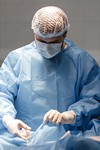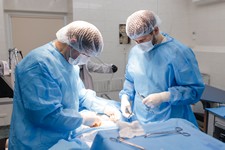

















Laparoscopy or open surgery? What to choose?
Laparoscopy or open surgery? What to choose?
For a long time, surgery has been associated with large incisions, prioritizing convenience for the surgeon. The virtuoso execution of intricate cuts, organ separation, and suturing, or even removing half of the body, were once considered true achievements of surgical science. The literal translation of the word "surgery" from Greek means "handiwork." Surgeons "worked with their hands" without thinking that the very act of rough intervention was causing harm to the patient – the one for whom the surgery was being performed to restore health. The trauma of such surgery weakened the body's defenses, complicating the healing process.
One of the main tasks of modern surgery is not only to perform successful operations, but to inflict as little trauma on the patient as possible. How does laparoscopy contribute to this?
Operative laparoscopy is a modern, high-tech method of performing surgery where the surgeon gains access to the organ through small punctures. A video camera inside the patient’s body transmits the image to a monitor, allowing the surgeon to see all organs and formations in great detail and perform precise manipulations with specialized equipment. Thanks to modern technology, the surgeon has a much clearer view of the operating area on the monitor than in classical surgery, where the doctor relies solely on their own vision. Only three to five small incisions, ranging from 0.5 to 1 cm, are made on the patient's body instead of a large abdominal incision. As a result, postoperative pain is minimized, reducing the need for pain medications. Consequently, the time spent in the intensive care unit is significantly shortened, there is no need for extended bed rest, minimizing the risk of pneumonia, and hospitalization is significantly reduced. Most importantly, in addition to resolving their health issue, the patient experiences a noticeable cosmetic effect – with almost invisible or entirely absent postoperative scars. Patients quickly recover their well-being and can return to their normal lifestyle. Today, the leading role of laparoscopy in the surgical treatment of cancer is undeniable. In "open" surgeries, the patient suffers primarily from the trauma of the surgical access itself, leading to pain, prolonged hospitalization, and postoperative complications. The advantages of minimally invasive surgery are indisputable. The entire necessary scope of intervention – which in oncology can be extensive – is performed with "minimal blood loss," reducing the operational trauma to a minimum. As a specialist, I would highlight these benefits of laparoscopic access: complete hemostasis; less tissue trauma during surgery; faster healing and rehabilitation; almost no postoperative complications; and the ability to perform simultaneous interventions on multiple organs if needed.
How wide is the range of operations that can be performed laparoscopically?
Virtually any surgery can be performed using laparoscopic access.
Some say that if a very thin person opts for laparoscopy, they will end up with highly visible scars, and it’s better to choose a “cosmetic suture,” while for obese individuals, laparoscopy is not an option at all...
After the small punctures needed for laparoscopic instruments, there are almost no scars left. No "cosmetic suture" in open surgery can offer the same aesthetic effect as minimally invasive surgery. As for obesity – it is not a contraindication for laparoscopic operations at all. In fact, laparoscopy offers numerous advantages for overweight individuals: the incidence of complications (such as pneumonia, wound infections, and hernias) is much lower compared to traditional surgery. Furthermore, laparoscopic surgeries can be safely performed on patients with multiple previous surgeries, regardless of the complexity or location of prior incisions. Laparoscopy is also justified in patients with severe comorbid conditions. I want to emphasize that, in every individual case, the choice of surgical technology is made jointly by the surgeon and the anesthesiologist.
Today, the leading role of laparoscopy in the surgical treatment of cancer is an undeniable fact.
However, despite its obvious advantages, laparoscopic surgery is surrounded by myths and legends many of which are harmful and sometimes dangerous. Unfortunately, these misconceptions are occasionally perpetuated by doctors who are not proficient in modern methods and who attempt to persuade patients to opt for "open" surgery.
We will discuss the myths surrounding laparoscopy in the next article.

